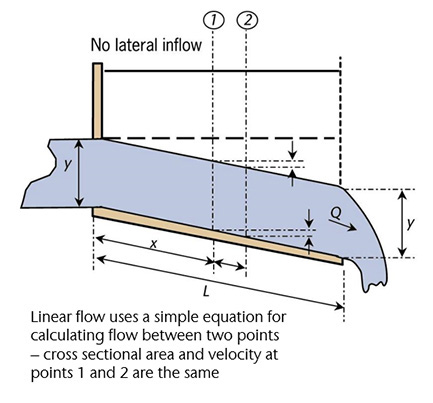Steady uniform flow and why it's a flawed approach for trench drains
Any textbook on fluid mechanics will define clearly the terms steady and uniform flow. A steady flow is one, which, at one place, does not change its velocity, or cross-section, with time. That is to say, the flow may change its cross-sectional area and velocity from section to section, but at each section they do not vary with time. An example of steady flow is a fluid travelling through a tapering pipe. Uniform flow, on the other hand, has the cross-sectional area and velocity of the fluid the same at each successive cross section. For example, flow in a pipe, with uniform cross-section, running full.
HYDRAULIC PERFORMANCE – Analysis of Steady Uniform Flow (Pipe Theory)
Trench run capacity is not effected by trench run length or spacing between outlets along the run.

THIS IS A FLAWED ASSUMPTION FOR GRATED TRENCH DRAINAGE SYSTEMS DUE TO THE CONTINUOUS LATERAL INTAKE ALONG THE RUN LENGTH

Surface water channels may be constructed with a sloping or constant depth, invert (or combination of both) throughout their length. As a consequence of the lateral inflow, from the drained area, increasing the flow in the channel per metre, velocity of flow increases. Subject to atmospheric pressure, the water surface profile falls in the direction of the outlet from the channel and the velocity of flow accelerates.
Physical snapshot of fluid flowing in a channel

As mentioned earlier, the slope of the channel bed, the water surface, and the total energy line are no longer parallel. That is, the flow in surface water channels is steady, but non-uniform. Clearly, the application of simple formulae (based on uniform flows) are no longer appropriate.
Mechanics shapshot of fluid flowing in a channel
The energy line is related to the velocity of the fluid. In a pipe, where velocity is constant, the energy line, water surface and bed slope are all parallel.

BUT if the velocity is NOT constant (i.e. Increasing), the energy line moves towards the horizontal. The 3 lines are no longer parallel.






